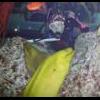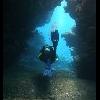
Reasons for getting the bends
#1

Posted 07 October 2005 - 02:45 PM
In all of my classes (especially SSI classes), instructors stressed that undeserved hits for no desernabile reason could and did happen.
What have others found?
http://www.cdnn.info...le/a051006.html
#2

Posted 07 October 2005 - 03:45 PM
Scott
:lam:
- Albert Einstein
"Do, or do not. There is no 'try'."
- Yoda ('The Empire Strikes Back')
"And the trees are all kept equal by hatch, axe, and saw"
- Rush (The Trees)
#3

Posted 07 October 2005 - 04:42 PM
The two points brought our by the article seem to be little known by divers I've encountered online:
(1) No strenuous exercise soon after. I really prefer removing my BC, tank, weights in the water, if the crew will accommodate me.
(2) No hot showers soon after. And I hate that. So often I get chilled on the safety stops - but then I do 5 minutes, along with a 1 minute deep stop and slow ascents. Kinda' excessive? I have to work at safety.
One analogy that helps me a lot is to compare to open bottles of carbonated beverages. Open one to sit all night and it goes flat without much bubbling. Shake or heat one, then open - a mess, indeed - a mess I don't want to have inside my body.
A few other strong points not completely well known.
(3) Work at hydration, starting the night before. I like a minimum 2 quarts of non-diuretic liquids a day, more to off set night before beers and morning coffee.
(4) STUDY THE COMPUTER MANUAL, not the card. Pelagic computers are said to be liberal, but not so compared to Padi tables. The books do say to exit in the green, not the yellow, tho, a page often not studied.
(5) Diving air is okay on some plans, but diving Nitrox on the same plans is better, yield shallower adjust air depths.

Yeah I know: I've been branded a non-group person - doesn't play well with others. I am so upset.
 Let me know if you want to have some fun, without the drama - I'm good for that.
Let me know if you want to have some fun, without the drama - I'm good for that.
#4

Posted 07 October 2005 - 05:53 PM
1) It's normal with dive boats in the UK which take tech divers to have a hoist and seat. The seat is lowered into the water, the diver sits in it, and is then hoisted above deck level, swung onto the deck, and lowered. Not because of laziness but for precisely this reason.
2) We offer hot showers, but straight after diving I caution people to keep is tepid. Yet a highly experienced techie who's dived with us took a hot shower after every dive, with no ill effects.
3) Hydration is vital, though I have no first hand experience of people who haven't hydrated.
4) Can't follow the bit about computers without reading the article.
5) We all dive nitrox when working as instructors or guides, for this reason.
In my 3.5 years of operating a dive center we have had two people in the chamber. The first was stupidity on the part of an experienced diver, the second the person was diving conservatively and had dived gently for several days. I don't know whether she had had a hot shower, but she certainly was properly hydrated, and was generally fit & healthy.
So yes - a bend can come "out of the blue".
#5

Posted 08 October 2005 - 08:03 AM
On the last day of diving in Coz I took a warm shower and about 30 minutes later the skin on my legs was tingeling but DAN said that was because of the SD women I was sitting with
By all that is wet, I do hereby swear, (politely), and attest, upon pain of never diving again, (real or imagined), that I understand and affirm, that I agree to the above.
_________________________________________(log in name signature)
Signed and Dated
#6

Posted 10 October 2005 - 05:15 PM
The very first culprit one would suspect in any DCS case would be a fast ascent rate. Many divers who think they are ascending at 30 feet per minute are actually ascending much faster than that. When I began diving, the ascent rate was 60 feet per minute, but the industry decided to cut back the ascent rate to 30 feet per minute in the 1980's as better decompression studies were being done. Now, we are becoming aware that making deeper stops on dives is even better than a safety stop at 15 feet for recreational dives and better than stops at 30, 20 and 10 feet for technical decompression dives. Haldanian and Buhlmann based dive tables are far less safe than the use of decompression software based on RGPM and VPM models such as V-Planner or GUE's Decoplanner. It is recommended that divers begin to pause at 80% of their maximum depth in ATA's and add a pause or stop into their dives every 10 feet. Without talking about technical diving procedures such as gas switches and the oxygen window, for the single tank recreational diver using a single gas such as air or nitrox, pausing will allow the diver to slow his or her ascent rate and create a safer dive profile.
The next culprit one would generally expect for a so called underserved hit would be a patent foramen ovale (PFO) or a "hole in the heart" that produces a right to left blood shunt. The condition is detected in 15% of the living population through contrast transthoracic echocardiography while autopsies on deceased members of the population show a 27% detection rate. For divers, this means that any N2 that is offgassing through the respiration process can actually shunt through an existing PFO as blood passes through the heart and come out of solution during ascent forming bubbles. If a diver is concerned about this condition color test Doppler studies can be done or CTE's or transesophageal contrast echocardiography can be performed. There is a surgical procedure that can close a PFO if tests show one exists. What is critical for most divers to realize is that exertion following a dive such as walking up a hill with equipment on, climbing a boat ladder or a rough surf exit can cause a temporary PFO by allowing the normally closed flap to pop open and create a shunt. Also, if a diver climbs out or exits the water immediately, he or she is further reducing the hydrostatic pressure of the water on the body removing what may be thought of as one's last safety or deco stop -- several critical minutes or more on the surface. Prudence would dictate that after any dive, especially a deep, cold or aggressive dive profile, a diver will take advantage of a surface resting period before climbing into a boat or leaving the water for shore.
Once these scenarios are considered, then the other factors such as hydration, a diver's age & physical health, temperature changes, etc. must be considered.
A note about exercise: Recent US Navy studies show that 20 or more minutes of cardio exercise prior to beginning scuba activity can help make decompression more efficient. Also, mild exercise during decompression diving adds to deco efficiency as well.
Trace
Edited by TraceMalin, 10 October 2005 - 05:29 PM.
Technical Training Director
PDIC International
#7

Posted 10 October 2005 - 05:36 PM
What is the practice called where you do your 1st safety stop at half your maximum depth.... then the 2nd at half of that.... and so on...Now, we are becoming aware that making deeper stops on dives is even better than a safety stop at 15 feet for recreational dives and better than stops at 30, 20 and 10 feet for technical decompression dives. Haldanian and Buhlmann based dive tables are far less safe than the use of decompression software based on RGPM and VPM models such as V-Planner or GUE's Decoplanner. It is recommended that divers begin to pause at 80% of their maximum depth in ATA's and add a pause or stop into their dives every 10 feet.
if you were at say 120 for a while .... you'd do a stop at 60... then at 30 .... then at 15...
What I prefer to do when possible is a staged accent in increments... Towards the end of the dive I will start to move up 10 or 15 feet every 2-3 minutes while swimming until I get to about 20'... I try to do 4-5 minutes there and another 3 at 15... Thought process being that it would be a gradual decompression/offgassing.
Any thoughts on that practice?
Thanks
#8

Posted 10 October 2005 - 05:49 PM
What is the practice called where you do your 1st safety stop at half your maximum depth.... then the 2nd at half of that.... and so on...
if you were at say 120 for a while .... you'd do a stop at 60... then at 30 .... then at 15...
What I prefer to do when possible is a staged accent in increments... Towards the end of the dive I will start to move up 10 or 15 feet every 2-3 minutes while swimming until I get to about 20'... I try to do 4-5 minutes there and another 3 at 15... Thought process being that it would be a gradual decompression/offgassing.
Any thoughts on that practice?
Well, I've started doing something similar. I've read the arguments back and forth about deep stops, but such a program enforces a doctrine of slow ascents (hopefully).
For example I did a 110 foot max dive in the Dry Tortugas, did a 3 minute stop at 60, 5 minute at 30 and a 5 minute at 15. We were hanging on a floating line, which made stops easy, but I personally felt good about it. (we were on 28 Eanx). Probably overlyconservative, but I had the gas.
#9

Posted 10 October 2005 - 07:06 PM
What is the practice called where you do your 1st safety stop at half your maximum depth.... then the 2nd at half of that.... and so on...
Do you mean a type of "ratio deco?"
Edited by TraceMalin, 10 October 2005 - 07:08 PM.
Technical Training Director
PDIC International
#10

Posted 10 October 2005 - 07:19 PM
I had heard of the practice, but I didn't know if there was a name for it or not... Thats a good discription I think however.What is the practice called where you do your 1st safety stop at half your maximum depth.... then the 2nd at half of that.... and so on...
Do you mean a type of "ratio deco?"
I haven't done any 'true' deco dives. Although I guess technically, every dive is a decompression dive - just a matter of how much time spent and where.. I've never ran my computer up to the point that I run out of bottom time and have to do a deco stop, but there are a few times that I have had most or all of the green bars lit (on both the nitrogen and oxygen scale)... I like to dive as high a percenage of Nitrox as they will give me... I've even gotten 40's before. I usually don't dive all that deep (unless there is something special to see) ... I'm more into seeing lots of things and having lots of bottom time to enjoy the sights.
Thanks for all the technical info... I'll be asking more questions as I spend more time here on the forum
#11

Posted 10 October 2005 - 07:53 PM
Reducing gradients/times by halves would seem to be a fairly large jump to me and would seem to be a compromise between a Haldanean jump to shallow depths for offgassing and the better gradual curve of a RGPM or a VPM planned dive. Ideally, it would be best to construct a better curve to your dive for a more optimal deco. For example, a 15 minute "no decompression" dive on air to 120 feet on V-Planner would ask a diver to perform the following stops in salt water:What I prefer to do when possible is a staged accent in increments... Towards the end of the dive I will start to move up 10 or 15 feet every 2-3 minutes while swimming until I get to about 20'... I try to do 4-5 minutes there and another 3 at 15... Thought process being that it would be a gradual decompression/offgassing.
Any thoughts on that practice?
DIVE PLAN
Surface interval = 1 day 0 hr 0 min.
Elevation = 0ft
Conservatism = Nominal
Dec to 120ft (2) Air 50ft/min descent.
Level 120ft 12:36 (15) Air 0.97 ppO2, 120ft ead
Asc to 30ft (18) Air -30ft/min ascent.
Stop at 30ft 1:00 (19) Air 0.40 ppO2, 30ft ead
Stop at 20ft 2:00 (21) Air 0.34 ppO2, 20ft ead
Stop at 10ft 5:00 (26) Air 0.27 ppO2, 10ft ead
Surface (26) Air -30ft/min ascent.
Off gassing starts at 76.3ft
OTU's this dive: 15
CNS Total: 5.1%
85.0 cu ft Air
85 cu ft TOTAL
Obviously, if this were a single tank dive then the diver might not have enough gas on an AL80 to complete it safely and this is set for nominal conservativism. By contrast, the greatest safety or conservative factor that would be allowed bt V-Planner would ask a diver for the following dive plan:
DIVE PLAN
Surface interval = 1 day 0 hr 0 min.
Elevation = 0ft
Conservatism = + 5
Dec to 120ft (2) Air 50ft/min descent.
Level 120ft 12:36 (15) Air 0.97 ppO2, 120ft ead
Asc to 50ft (17) Air -30ft/min ascent.
Stop at 50ft 0:40 (18) Air 0.53 ppO2, 50ft ead
Stop at 40ft 3:00 (21) Air 0.46 ppO2, 40ft ead
Stop at 30ft 3:00 (24) Air 0.40 ppO2, 30ft ead
Stop at 20ft 5:00 (29) Air 0.34 ppO2, 20ft ead
Stop at 10ft 11:00 (40) Air 0.27 ppO2, 10ft ead
Surface (40) Air -30ft/min ascent.
Off gassing starts at 76.3ft
OTU's this dive: 15
CNS Total: 5.1%
103.3 cu ft Air
103.3 cu ft TOTAL
Here, after viewing the two plans, you can get a better idea of the curve that is going on with the deco. You can see that the times are increasing by around half for each 10 feet of ascent in both plans, but the hang times are constantly increasing with each shallower depth. So, what you're doing is nearly the same thing, but you'd just want to tweak your 20 and 10 foot stop a bit. Rather than doing 4 to 5 minutes at 20 then dropping to 3 minutes at 15, you'd be creating a better curve if you did say 2 to 3 minutes at 20 feet and then do 5 to 6 minutes at 10 feet and then chill for 10 minutes or more right at the surface before leaving the water. If you want to add that 15 foot stop, I'd just incorporate it into my 20 foot stop time. For example, if you want to do the 4 to 5 minutes at 20 like you're already doing, do 2 minutes at 20 then either do another 2 or 3 minutes at 15 then expand that to 6 minutes or so at ten.
It's easy enough to construct a curve when you have a baseline. I like starting from 80% of the maximum depth you reach in the dive in ATA's then build it from there. It's very important for single tank divers to realize that bottom times become very limited when planning deeper recreational dives if they plan to use any software or mentally construct a deco curve especially since you should plan dives so that you are always in control and an OOG situation would still allow two divers to ascend following the planned safety stops. It's true you can probably blow the whole curve and make a direct ascent when not doing any deco diving, but it also helps develop better attention to dive planning if you start incorporating gas management into deco planning.
Trace
Technical Training Director
PDIC International
#12

Posted 11 October 2005 - 10:55 AM
TraceSo, what you're doing is nearly the same thing, but you'd just want to tweak your 20 and 10 foot stop a bit. Rather than doing 4 to 5 minutes at 20 then dropping to 3 minutes at 15, you'd be creating a better curve if you did say 2 to 3 minutes at 20 feet and then do 5 to 6 minutes at 10 feet and then chill for 10 minutes or more right at the surface before leaving the water.
Thanks for the in-depth info... I'll do a little adjusting for longer hangs in the shallower depths... I usually have plenty in my tank at the end of the dive, so that shouldn't be a problem at all...
KC
0 user(s) are reading this topic
0 members, 0 guests, 0 anonymous users


















